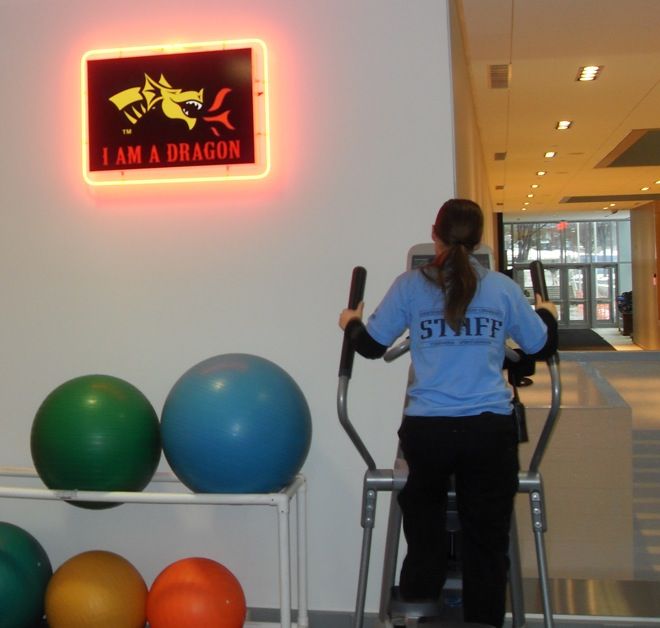It sounds like an idea from a 1950’s “House of Tomorrow” cartoon. There is Junior, off to college, and in need of a little exercise. He heads over to the college gym, and through his physical activity he powers the neighborhood. Look at Junior go.
In the workout rooms of more than 25 college and university campuses across the country, athletic departments have retrofitted their exercise equipment to take advantage of energy created while working out. With the aid of new technology, energy typically converted into heat is captured and sent back into the building’s grid — a human-powered gym, if you will. Intrigued by the concept, I headed to Drexel University in Philadelphia to see their take on the “Recreation Center of Tomorrow” — a line of Precor ellipticals outfitted with ReRev technology in early 2010.
Steve Koch, Drexel’s Assistant Director of Recreation, walked me through a mostly empty gym on commencement weekend to Drexel’s eco-friendly wall of exercise equipment. A colorful poster to the right of the equipment challenges students to turn their “energy into electricity.” Four elliptical machines stand against the wall, each capable of producing about 50 watt hours of energy over a typical 30-minute workout —enough to light a CFL light bulb for 2.5 hours.
Both Koch and Erik Crudele, the building engineer, said that they believe the machines have a cost savings benefit, but with a $12,000-$14,000 installation cost for about a dozen machines, even with heavy usage, the university would be happy to recoup their investment in 20 years.
Drexel’s set-up seemed to emphasize the educational value of the equipment over energy conservation. Along with the poster describing the ReRev process — kinetic energy is converted into a DC current by the exercise machine (used to power the display), and ReRev converts the leftover DC current to AC power, channeling it back into the building’s energy grid — the machines are connected to a neon Drexel dragon logo. When a student hops onto the elliptical to begin exercising, the brightness of the sign serves as a physical reminder of the energy they are creating.
“The ReRev machines have had a huge impact,” Koch told me. “Students love to see how much energy they are creating. It takes surprisingly little energy to light up that sign.”
Crudele said that the machines were just one of many energy saving investments Drexel made when the building was constructed — the 240,000 square foot LEED-certified facility opened in February 2010. “We’re at the mercy of technology and the dollars and cents that can go into a building like this,” he said. “These machines are a great addition, but they are just one of many things we are doing.”
ReRev Inc. was founded in 2008 by Hudson Harr, a 25-year old serial entrepreneur (now on his eighth company) from St. Petersburg, Florida. Harr currently serves as the President of SunQuest Energy, which creates consumer solar products and serves as the umbrella for a number of smaller sustainable operations, including ReRev.
Harr chose to major in finance at the University of Florida because it allowed him to graduate in the quickest amount of time — he left to start doing “the real thing” after 2.5 years — but he primarily considers himself an engineer. One of his first companies was ReRain, which creates cisterns that captured and used rainwater at the source. “For the longest time I’ve been interested in capturing energy closer to the demand and saving all of the line losses that are typically experienced,” he told me over a phone call to the SunQuest headquarters — a small office, Harr answered the main number himself. ReRev follows in the same tradition, Harr said, finding wasted energy and trying to convert it to a reusable source at the point of origin.
After opening in a privately owned workout facility, the company has had initial success primarily working with colleges and universities. Glen Johansen, Vice President of Sales at ReRev said, “We’ve never marketed ReRev as an educational device, but universities sometimes see it as that. They see it as a cutting edge tool that can demonstrate the need to harness energy where it otherwise is being wasted.”
With foot traffic in the thousands —Koch said Drexel’s facility sees around 3,500 students per day — universities are also home to some of the world’s most heavily trafficked gyms. “It’s amazing what the utility bills can run,” Johansen said. “So they are looking for ways to save as well.”
Openness to sustainable technology and a need to conserve costs has positioned the university recreation center as the incubator for green workout technology. Shortly before I ended my visit to Drexel, Koch showed off one of the University’s new arrivals. Next to the ReRev ellipticals, painted bright green without irony, stood the Woodway EcoMill treadmill, officially released last summer. With a banana-like curve to its running track, the tread moves with its runner, generating more power the faster she goes.
As one of the most popular pieces of equipment in any recreation facility, the energy consumption of a line of treadmills can dominate the utility costs of a facility. The 100-percent self-powered EcoMill doesn’t even have a plug. And with ReRev technology added, maybe Junior really could power the neighborhood, at least one light bulb at a time.
















